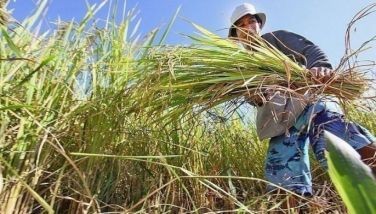DOST-PCAARRD provides seaweed farming training
MANILA, Philippines - As a form of assistance to Typhoon Pablo-stricken communities of Davao Oriental and Compostela Valley, DOST’s Philippine Council for Agriculture, Aquatic and Natural Resources Research and Development (DOST-PCAARRD) provided funding to help five barangays learn seaweed farming as an alternative source of livelihood.
The details of the project was presented by the project leader, Cyril Tom Ranara of the Davao del Norte State College (DNSC) during the Seaweed Fiesta held at the Passig Islet, Bato, Santa Cruz, Davao del Sur held in November last year.
The event is part of the Farming and Industries Encounters through the Science and Technology Agenda or FIESTA, a DOST-PCAARRD initiative.
FIESTA is a technology transfer modality that bridges farmers and the micro, small, and medium-scale industries through a science and technology-based platform.
The five barangays identified in Compostela Valley were Barangay Cuambog and Bongabong, while those in Davao Oriental were Barangay Poblacion, San Victor, and Kinablangan. Four hands-on training on seaweed production were conducted in the two provinces which benefited 141 fisherfolk and members of the local government unit (LGU). The trainings were held from July to November 2013.
Aside from the trainings, the project also ensured that seaweed farms and seaweed seedling banks were established. Employing the raft culture method in establishing the farms, the technology ensures a two month-growing period before harvest. From 70 metric tons of seedlings given to the five barangays, about 288 metric tons of seaweeds were estimated as net harvest.
The project titled “Pangtawid Project for the Rehabilitation of Davao Oriental and Compostela Valley brought about by Typhoon Pablo through Seaweed Farming” was supported by cooperating agencies DOST Region 11, Provincial S&T Office, LGU of Davao Oriental and Compostela Valley, UP Marine Science Institute, and the Bureau of Fisheries and Aquatic Resources (BFAR).
Farming of fast-growing seaweed varieties of Kappaphycus and Euchema, such as the Sacol and Tambalang varieties, is an economical livelihood alternative for residents in coastal communities. It is also one of the important industries that contribute to the country’s economy, especially since the country produces more than 92% of the world’s supply of Euchema.
Seaweed farming was introduced to Davao Oriental and Compostela Valley after Typhoon Pablo devastated the Davao region, affecting 5.5 million people or 528,000 families. The typhoon damaged P14.3 billion of infrastructure, P9.7 billion of agriculture, and P48.7 million of private properties.
- Latest

























